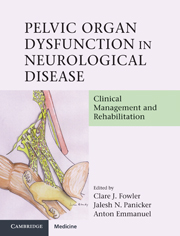Book contents
- Pelvic Organ Dysfunction in Neurological Disease
- Pelvic Organ Dysfunction in Neurological Disease
- Copyright page
- Contents
- Contributors
- Foreword
- Preface
- Section 1 Neurological control of pelvic organ functions
- Section 2 Evaluation and management
- Chapter 4 Approach and evaluation of neurogenic bladder dysfunction
- Chapter 5 General measures and non-pharmacological approaches
- Chapter 6 Neurogenic bladder dysfunction: pharmacological interventional approaches
- Chapter 7 Neurogenic bladder dysfunction: surgical interventional approaches
- Chapter 8 Approach and evaluation of neurogenic bowel dysfunction
- Chapter 9 Neurogenic bowel management
- Chapeter 10 Evaluation and management of neurogenic sexual dysfunction
- Section 3 Specific conditions
- Appendix 1: Management algorithms
- Appendix 2: Surveys and questionnaires
- Index
Chapter 9 - Neurogenic bowel management
from Section 2 - Evaluation and management
Published online by Cambridge University Press: 06 December 2010
- Pelvic Organ Dysfunction in Neurological Disease
- Pelvic Organ Dysfunction in Neurological Disease
- Copyright page
- Contents
- Contributors
- Foreword
- Preface
- Section 1 Neurological control of pelvic organ functions
- Section 2 Evaluation and management
- Chapter 4 Approach and evaluation of neurogenic bladder dysfunction
- Chapter 5 General measures and non-pharmacological approaches
- Chapter 6 Neurogenic bladder dysfunction: pharmacological interventional approaches
- Chapter 7 Neurogenic bladder dysfunction: surgical interventional approaches
- Chapter 8 Approach and evaluation of neurogenic bowel dysfunction
- Chapter 9 Neurogenic bowel management
- Chapeter 10 Evaluation and management of neurogenic sexual dysfunction
- Section 3 Specific conditions
- Appendix 1: Management algorithms
- Appendix 2: Surveys and questionnaires
- Index
Summary
- Type
- Chapter
- Information
- Pelvic Organ Dysfunction in Neurological DiseaseClinical Management and Rehabilitation, pp. 138 - 152Publisher: Cambridge University PressPrint publication year: 2010



